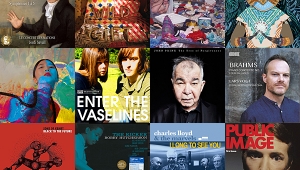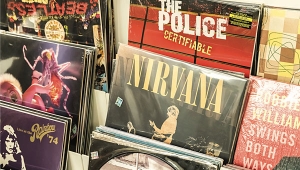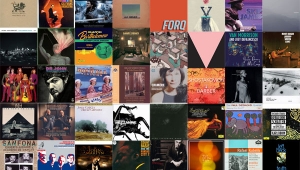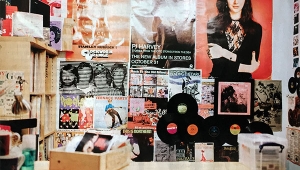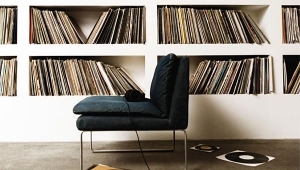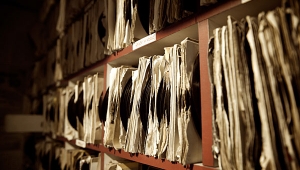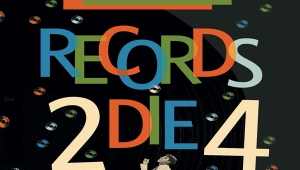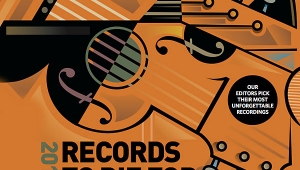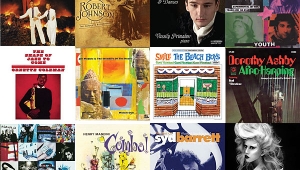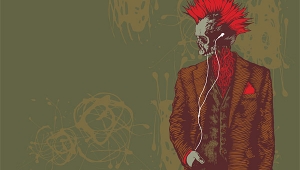| Columns Retired Columns & Blogs |
2001 Records to Die For Page 7
Robert J. Reina
THE AMBOY DUKES FEATURING TED NUGENT: Marriage On the Rocks/Rock Bottom
Polydor 24-4012 (LP). 1969. The Amboy Dukes, prods.; Edwin H. Kramer, prod., eng. AAA.
If we go back to that narrow two-year period, 1969-70, after Ted Nugent had finished creating catchy flower-pop with the original Amboy Dukes but well before he'd gotten into his trashy gonzo-metal guitar rock (even he admits that he had to sell out in order to eat), you'll find the Motor City bad boy leading a uniquely sophisticated quintet that churned out the most structured psychedelic rock of the '60s. On this highly original studio recording engineered by Eddie Kramer (save for an excerpted Bartók string quartet cover) are the most elaborate arrangements of original rock tunes outside the Beatles. The highlight is the title track, a three-movement, nine-minute instrumental that demonstrates why Nugent—with his cranked Gibson Byrdland jazz guitar—and not Jimi Hendrix is the master of controlled guitar sustain and feedback. I bought the LP when it was released, and it became the favorite record of my collection. More than 10,000 albums and 31 years later, it still is.
DENA DE ROSE: Another World
Dena DeRose, vocals, piano; Steve Wilson, soprano sax; Ingrid Jensen, trumpet; Steve Davis, trombone; Dwayne Burno, bass; Mark Taylor, drums; Daniel Sadownick, percussion
Sharp Nine 1016-2 (CD). 1998. Marc Edelman, Ken Mirsky, prods.; Mike Marciano, eng. DDD. TT: 56:00
Dena DeRose is New York City's latest entrant in the female jazz vocalist/pianist sweepstakes. This, her second recording, is an excellent showcase for her uniquely forceful yet intimate and dynamic vocal style, whose rubato phrasing at times recalls that of a virtuoso saxophonist. She is even a stronger pianist than vocalist, but in these sophisticated sextet arrangements (all hers) she mostly uses the piano tastefully as an ensemble instrument. (Not so in her live trio performances. In a recent concert performance, her piano solos reached a level of intensity that I've seen exceeded only by Cecil Taylor or Keith Jarrett—think Bill Evans with two cups of espresso.) The highlight is this CD's single original, "Don't Go"; I wish there were more, but in today's jazz market, if you wanna get gigs, you gotta play standards. If you like Diana Krall and Patricia Barber, you'll enjoy this recording even more. Better still, if you're in New York, catch her live.
THE BEATLES: Beatles for Sale
Parlophone PMC1240 (LP), Capitol CDP 7 46438 2 (CD). 1964. George Martin, prod. AAA/AAD. TT: 34:13
Everybody's always talking about Sgt. Pepper's and the later Beatles records, but in my house, it's the first five, the amazing sound of Beatlemania—Please Please Me, With The Beatles, A Hard Day's Night, Beatles for Sale, and Help!—that are in regular rotation. They always seem fresh. In the company of its exuberant predecessors, the more somber and thoughtful For Sale is largely ignored. This dark horse has a special place in my heart, having brought me back to the Four after an early youth burning out on saturation airplay. Seldom-heard songs like "Baby's in Black" and "I'm a Loser" seemed absolutely brand-new to me. It's also one of my favorite demo discs. I have about every issue of this record, and when you play the original UK mono after any of 'em, there's an intimacy and familiarity to the vocals that nobody fails to hear. It's positively thrilling. It's a shame that practically no one gets to hear what the Beatles are meant to sound like. On the other hand, we few are blessed that, with help from George Martin, the Beatles not only made great records, but made those records really, really well.
CECIL TAYLOR: Air Above Mountains (Buildings Within)
Cecil Taylor, piano
Inner City 3021 (LP), Enja ENJ-3005 (CD). 1976. Horst Weber, Matthias Winckerman, prods.; Walter Kramper, eng.; Ulrich Kraus, digital mastering (CD). AAA/ADD. TTs: 51:17, 76:15
You've heard of those studies indicating that listening to Mozart before a test makes you smarter? Well, listening to Cecil Taylor's solo piano will make you a freakin' genius. It's like classical piano, yet with myriad themes and sub-themes developing, overlapping, trailing off, and picking up again. Trying to follow all of the threads can be overwhelming, but I find that when I listen to any of Taylor's solo work I think of nothing else. By the time one of his extended compositions is finished, my mind is refreshed and ready to focus. I like the weight of this piece, and the big Bösendorfer sound. Think of it as a burn-in disc for degaussing your mind.
ELGAR-PAYNE: Symphony 3
Paul Daniel, Bournemouth Symphony Orchestra
Naxos 8.554719 (CD). 2000. Andrew Walton, prod.; Tony Faulkner, eng. DDD. TT: 54:59
This work has a dual attribution because Anthony Payne has realized ("elaborated," according to the notes) a full-blooded symphony from the sketches left behind by Edward Elgar. Elgar's notes provided orchestration for only brief portions of the work, and those only in "short score." I have never been completely won over by Elgar's earlier symphonies, which I find too iterative and extended despite their powerful sweep. Payne's realization has all the Elgarian vigor, but expressed with a greater sense of determined closure. The scoring is appropriate—delicious and expansive, with hints of Sibelius and Hindemith. Paul Daniel leads the Bournemouth Symphony with great panache and easily supersedes the Andrew Davis/BBC premiere recording. Felicitously, Tony Faulkner's recording, using 176.4kHz-sampled masters, captures all the power and depth of the Bournemouth at the Guildhall, Southhampton, recalling the sound of their glorious golden-age-of-LP HMV Sibelius and Shostakovich performances. Those who love Elgar's music—and, perhaps even more, those who have not yet discovered his groove—should try this one.
DAVID JOHANSEN AND THE HARRY SMITHS
Chesky JD196 (CD). 2000. David Chesky, Brian Koonan, prods.; Norman Chesky, Hank Medress, exec. prods.; Barry Wolifson, eng. DDD. TT: 50:23
From his days with the New York Dolls and on through the Buster Poindexter masquerade, David Johansen has been a protean force, making music and film across a dazzling swath of styles and tastes. While I have always respected his talent, this disc is his first musical presentation to fully impress and satisfy me. For each of these songs, most drawn from the Harry Smith folk-blues archives, Johansen adopts a subtly different vocal sound that fits perfectly. Each accompaniment, too, is conceived and executed to be as gritty, mournful, pleading, or cynical as suits the message. It's music-making as high art—all wonderfully entertaining, and aesthetically faithful to the originals. (And any disc with Oscar Brown, Jr.'s "Somebody Buy Me a Drink" deserves a spin.) Chesky's intimate sound is state-of-the-art, and everything from the twangy guitar on "Little Geneva" to the thigh-slapping on "Old Dog Blue" is grippingly close-up. A disc "in heavy rotation" for reviewing, relaxing, and reveling.
MOBY: Play
Rave New World V2 63881-27049-2 (CD). 2000. Moby, prods., engs. TT: 63:12
Mix a walloping dollop of iconoclasm with sparkling, frenetic musical creativity, add respect for and acknowledgment of pop's past to trance, rave, and trip-hop, plus a thousand-yard stare into music's future. Bake till golden-brown and you've got Moby—pure and endearing performance art. I can't stop sympathetically and spasmodically bouncing around every time I play Play. Moby never wears on me—there's always something fresh to find within. It's romantic, touching, confusing, unexpected, wild'n'woolly, and very well recorded. Moby knows where we're all headed. Meet you there!
THELONIOUS MONK: Straight, No Chaser
Thelonious Monk, piano; Charlie Rouse, tenor sax; Larry Gales, bass; Ben Riley, drums
Columbia CS 64886 (SACD). Ted Maceo, prod.; Frank Laico, Orrin Keepnews, reissue prods.; Steve Berkowitz, Kevin Gore, reissue exec. prods.; Mark Wilder, reissue eng. TT: 76:03
This SACD remastering includes the original 1967 release plus two previously unissued bonus tracks, and the entire album is a showcase for Monk's towering talent. The recording is detailed and chock-full of acoustic information. What a hubbub they all make while singin', hummin, 'n' thrummin' along with these fabulous tunes. Monk sounds like a bullfrog croaking along with "Between the Devil and the Deep Blue Sea," and "We See" is joyous beyond telling. Charlie Rouse's tenor sax was never so brilliantly recorded, and Larry Gales' bass is a wonder to behold. Clearly these guys were very deep into each others' heads as they made music. Does jazz—does any music—get any better than the glorious cover of "Straight, No Chaser"? I don't think so. An indispensable recording for any Monkhead: sublime, accessible music played with that certain touch of genius. Don't miss it. A recording to cherish forever. (XIII-4, XX-6)
THE AMBOY DUKES FEATURING TED NUGENT: Marriage On the Rocks/Rock Bottom
Polydor 24-4012 (LP). 1969. The Amboy Dukes, prods.; Edwin H. Kramer, prod., eng. AAA.
If we go back to that narrow two-year period, 1969-70, after Ted Nugent had finished creating catchy flower-pop with the original Amboy Dukes but well before he'd gotten into his trashy gonzo-metal guitar rock (even he admits that he had to sell out in order to eat), you'll find the Motor City bad boy leading a uniquely sophisticated quintet that churned out the most structured psychedelic rock of the '60s. On this highly original studio recording engineered by Eddie Kramer (save for an excerpted Bartók string quartet cover) are the most elaborate arrangements of original rock tunes outside the Beatles. The highlight is the title track, a three-movement, nine-minute instrumental that demonstrates why Nugent—with his cranked Gibson Byrdland jazz guitar—and not Jimi Hendrix is the master of controlled guitar sustain and feedback. I bought the LP when it was released, and it became the favorite record of my collection. More than 10,000 albums and 31 years later, it still is.
DENA DE ROSE: Another World
Dena DeRose, vocals, piano; Steve Wilson, soprano sax; Ingrid Jensen, trumpet; Steve Davis, trombone; Dwayne Burno, bass; Mark Taylor, drums; Daniel Sadownick, percussion
Sharp Nine 1016-2 (CD). 1998. Marc Edelman, Ken Mirsky, prods.; Mike Marciano, eng. DDD. TT: 56:00
Dena DeRose is New York City's latest entrant in the female jazz vocalist/pianist sweepstakes. This, her second recording, is an excellent showcase for her uniquely forceful yet intimate and dynamic vocal style, whose rubato phrasing at times recalls that of a virtuoso saxophonist. She is even a stronger pianist than vocalist, but in these sophisticated sextet arrangements (all hers) she mostly uses the piano tastefully as an ensemble instrument. (Not so in her live trio performances. In a recent concert performance, her piano solos reached a level of intensity that I've seen exceeded only by Cecil Taylor or Keith Jarrett—think Bill Evans with two cups of espresso.) The highlight is this CD's single original, "Don't Go"; I wish there were more, but in today's jazz market, if you wanna get gigs, you gotta play standards. If you like Diana Krall and Patricia Barber, you'll enjoy this recording even more. Better still, if you're in New York, catch her live.
![]()
Richard J. Rosen
THE BEATLES: Beatles for Sale
Parlophone PMC1240 (LP), Capitol CDP 7 46438 2 (CD). 1964. George Martin, prod. AAA/AAD. TT: 34:13
Everybody's always talking about Sgt. Pepper's and the later Beatles records, but in my house, it's the first five, the amazing sound of Beatlemania—Please Please Me, With The Beatles, A Hard Day's Night, Beatles for Sale, and Help!—that are in regular rotation. They always seem fresh. In the company of its exuberant predecessors, the more somber and thoughtful For Sale is largely ignored. This dark horse has a special place in my heart, having brought me back to the Four after an early youth burning out on saturation airplay. Seldom-heard songs like "Baby's in Black" and "I'm a Loser" seemed absolutely brand-new to me. It's also one of my favorite demo discs. I have about every issue of this record, and when you play the original UK mono after any of 'em, there's an intimacy and familiarity to the vocals that nobody fails to hear. It's positively thrilling. It's a shame that practically no one gets to hear what the Beatles are meant to sound like. On the other hand, we few are blessed that, with help from George Martin, the Beatles not only made great records, but made those records really, really well.
CECIL TAYLOR: Air Above Mountains (Buildings Within)
Cecil Taylor, piano
Inner City 3021 (LP), Enja ENJ-3005 (CD). 1976. Horst Weber, Matthias Winckerman, prods.; Walter Kramper, eng.; Ulrich Kraus, digital mastering (CD). AAA/ADD. TTs: 51:17, 76:15
You've heard of those studies indicating that listening to Mozart before a test makes you smarter? Well, listening to Cecil Taylor's solo piano will make you a freakin' genius. It's like classical piano, yet with myriad themes and sub-themes developing, overlapping, trailing off, and picking up again. Trying to follow all of the threads can be overwhelming, but I find that when I listen to any of Taylor's solo work I think of nothing else. By the time one of his extended compositions is finished, my mind is refreshed and ready to focus. I like the weight of this piece, and the big Bösendorfer sound. Think of it as a burn-in disc for degaussing your mind.
![]()
Kalman Rubinson
ELGAR-PAYNE: Symphony 3
Paul Daniel, Bournemouth Symphony Orchestra
Naxos 8.554719 (CD). 2000. Andrew Walton, prod.; Tony Faulkner, eng. DDD. TT: 54:59
This work has a dual attribution because Anthony Payne has realized ("elaborated," according to the notes) a full-blooded symphony from the sketches left behind by Edward Elgar. Elgar's notes provided orchestration for only brief portions of the work, and those only in "short score." I have never been completely won over by Elgar's earlier symphonies, which I find too iterative and extended despite their powerful sweep. Payne's realization has all the Elgarian vigor, but expressed with a greater sense of determined closure. The scoring is appropriate—delicious and expansive, with hints of Sibelius and Hindemith. Paul Daniel leads the Bournemouth Symphony with great panache and easily supersedes the Andrew Davis/BBC premiere recording. Felicitously, Tony Faulkner's recording, using 176.4kHz-sampled masters, captures all the power and depth of the Bournemouth at the Guildhall, Southhampton, recalling the sound of their glorious golden-age-of-LP HMV Sibelius and Shostakovich performances. Those who love Elgar's music—and, perhaps even more, those who have not yet discovered his groove—should try this one.
DAVID JOHANSEN AND THE HARRY SMITHS
Chesky JD196 (CD). 2000. David Chesky, Brian Koonan, prods.; Norman Chesky, Hank Medress, exec. prods.; Barry Wolifson, eng. DDD. TT: 50:23
From his days with the New York Dolls and on through the Buster Poindexter masquerade, David Johansen has been a protean force, making music and film across a dazzling swath of styles and tastes. While I have always respected his talent, this disc is his first musical presentation to fully impress and satisfy me. For each of these songs, most drawn from the Harry Smith folk-blues archives, Johansen adopts a subtly different vocal sound that fits perfectly. Each accompaniment, too, is conceived and executed to be as gritty, mournful, pleading, or cynical as suits the message. It's music-making as high art—all wonderfully entertaining, and aesthetically faithful to the originals. (And any disc with Oscar Brown, Jr.'s "Somebody Buy Me a Drink" deserves a spin.) Chesky's intimate sound is state-of-the-art, and everything from the twangy guitar on "Little Geneva" to the thigh-slapping on "Old Dog Blue" is grippingly close-up. A disc "in heavy rotation" for reviewing, relaxing, and reveling.
![]()
Jonathan Scull
MOBY: Play
Rave New World V2 63881-27049-2 (CD). 2000. Moby, prods., engs. TT: 63:12
Mix a walloping dollop of iconoclasm with sparkling, frenetic musical creativity, add respect for and acknowledgment of pop's past to trance, rave, and trip-hop, plus a thousand-yard stare into music's future. Bake till golden-brown and you've got Moby—pure and endearing performance art. I can't stop sympathetically and spasmodically bouncing around every time I play Play. Moby never wears on me—there's always something fresh to find within. It's romantic, touching, confusing, unexpected, wild'n'woolly, and very well recorded. Moby knows where we're all headed. Meet you there!
THELONIOUS MONK: Straight, No Chaser
Thelonious Monk, piano; Charlie Rouse, tenor sax; Larry Gales, bass; Ben Riley, drums
Columbia CS 64886 (SACD). Ted Maceo, prod.; Frank Laico, Orrin Keepnews, reissue prods.; Steve Berkowitz, Kevin Gore, reissue exec. prods.; Mark Wilder, reissue eng. TT: 76:03
This SACD remastering includes the original 1967 release plus two previously unissued bonus tracks, and the entire album is a showcase for Monk's towering talent. The recording is detailed and chock-full of acoustic information. What a hubbub they all make while singin', hummin, 'n' thrummin' along with these fabulous tunes. Monk sounds like a bullfrog croaking along with "Between the Devil and the Deep Blue Sea," and "We See" is joyous beyond telling. Charlie Rouse's tenor sax was never so brilliantly recorded, and Larry Gales' bass is a wonder to behold. Clearly these guys were very deep into each others' heads as they made music. Does jazz—does any music—get any better than the glorious cover of "Straight, No Chaser"? I don't think so. An indispensable recording for any Monkhead: sublime, accessible music played with that certain touch of genius. Don't miss it. A recording to cherish forever. (XIII-4, XX-6)
- Log in or register to post comments

